Newsletter
Current
Previous
|
August 2024
|
|
|
|
|
Birds are a recurring theme in this issue of the Newsletter, and would have been so even more had another page been available. (I know, next time perhaps?) Our annual dawn chorus walk took place shortly after the previous issue was published, and over the summer several ornithological visitors have produced chicks not regularly seen on Maiden Erlegh lake: herons, grebes, tufted ducks – even buzzards in adjoining Moor Copse. And on the wider stage, our resident ornithologist Ray Reedman has had his latest book on bird names published, to critical acclaim. We include an introductory article by Ray and, though he’s too modest to mention them, extracts from some of the reviews. A follow-up article is in the stocks for the December issue. The perambulating Canada geese of Maiden Erlegh are another subject that will have to wait, as we compare their range and numbers with those of last year. But there is plenty to read within, right now …
Edwin
|
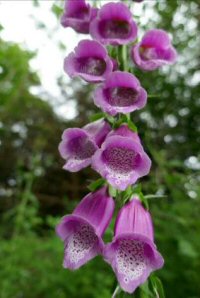
Foxgloves have been prolific this year
|
Summer sunlight

Photo: Edwin Trout
Sunlight on early summer leaves
|
|
|
|
Committee News
Announcements from the latest committee meeting and a report from the Wednesday Volunteers
EEG Committee
Paul Rose has joined the committee and attended his first meeting in early July.
Stewart Macleod is taking over maintenance of the EEG website.
Bob and Grahame helped set up and ran the Wokingham Workshop for the Berks Local Nature Recovery Strategy (LNRS) at Maiden Place on Saturday 20th April 2024. It went very well.
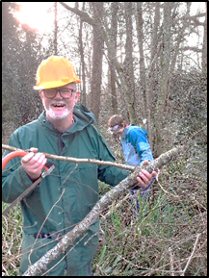
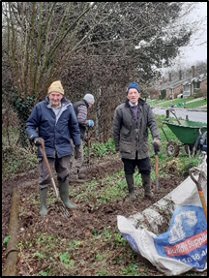
|
The Wednesday Volunteers
– six months of great work
Each year, Earley Town Council’s Wednesday Volunteers undertake an amazing variety of tasks at the Maiden Erlegh Local Nature Reserve and other green spaces around the area. Working on Wednesday mornings (unsurprisingly), they support Earley’s Park Rangers by contributing to the upkeep of our green spaces, protecting the local environment and making Earley a better place to live. The volunteers’ tasks are supervised by rangers Ashley and Tanika although, before his retirement in February, Grahame Hawker led the work. The council provides the equipment and the half-time refreshments; the volunteers provide the humour and the spirit to get things done. The first six months of this year have seen an exceptional number of tasks completed by the volunteers across Earley, as summarised below.
Maiden Erlegh Nature Reserve
(including Old Lane Woods, Old Pond Copse and Oak Wood)
Maintenance activities have included cutting back holly and removing extensive ground ivy from the woodland floor. Ivy removal is the volunteers’ least favourite task, as they need to be on their hands and knees, but it encourages wildflower growth – and it works! The volunteers also cut down some of the willow and hazel near the small weir and stream at the wetland area of Old Pond Copse to help revitalise the pond (left top). The regular gravelling and woodchip top-up of the surface of the woodland footpaths continued, as did the maintenance of the hedge along Lakeside. The heavy and continuous rainfall experienced earlier this year made drainage a key issue in the Reserve. Drainage gullies were dug adjacent to the footpath alongside Lakeside, at the bottom of the meadow to catch surface-water run-off, and to ease the extensive flooding across the path at Old Lane Wood near the path to Brookside.
The volunteers also improved the condition and drainage of the path leading to the disabled fishing bays at the lake in preparation for the fishing season. In the meadow, additional rubberised mats were installed along one of the muddy sections of the main footpath to improve the overall walking conditions.
The spring maintenance of the Butterfly Garden in Instow Road commenced once again (left bottom), with each volunteer now allocated a ‘flower patch’ to look after, and hopefully encourage more butterflies. 1,000 snowdrops were planted in Old Lane Wood in memory of the late Roger Hook (a loyal Wednesday Volunteer), and 2,000 snowdrops were planted in Oak Wood (south of the lake).
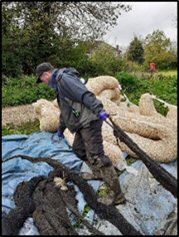 One of the smelliest tasks undertaken by the volunteers is the removal of the previous season’s barley straw ‘sausages’ from the lake inlet (see left) and then installing replacement sausages there; the sausages help reduce algae and pollutants entering the lake. The large hedge surrounding the weir at the lake was also cut back, in preparation for the 10-year lake inspection.
One of the smelliest tasks undertaken by the volunteers is the removal of the previous season’s barley straw ‘sausages’ from the lake inlet (see left) and then installing replacement sausages there; the sausages help reduce algae and pollutants entering the lake. The large hedge surrounding the weir at the lake was also cut back, in preparation for the 10-year lake inspection.
|
|
|
|
Wednesday Volunteers 2
Culver Lane Allotments
At the Town Council’s Culver Lane Allotments, the volunteers filled in the potholes in the carpark and levelled the surface with gravel. Also, on one of the few hot days of the early summer, they weeded the barked areas around the raised beds at plot number 2 of the allotments (bottom right), and cut back vegetation around the front gate – and revealed the allotment sign!
Earley’s Wild Flower Beds
Early in the year the volunteers helped dig and prepare the wildflower beds at Rushey Way, Beech Lane and at the Toby Carvery in readiness for the spring seeding. The wildflowers have been again spectacular and remain popular, so it was worth the early start and the hard work!
Redhatch Copse
At Redhatch Copse, the wet spring meant that the volunteers twice had to cut back the vegetation that had overgrown the footpath running around the copse; removing brambles, nettles and overhanging branches (bottom right).
Meadow Park
Meadow Park’s flower beds got a weeding as did the bed of the large cedar tree just inside the entrance. New woodchip was then laid, and a general pruning applied to trees and shrubs.
Paddick Drive
At the Paddick Drive community orchard the volunteers cut back the large area of blackthorn growth that has been invading the meadow area. They also removed the weeds around the community orchard trees and applied new woodchip.
‘Well done’ to the Wednesday Volunteers – a great asset to Earley’s green environment!
Ashley Prior and Bob Collis
|
The EEG’s 2025 Calendar Now on Sale
The EEG’s 6th Community Calendar, ‘Nature in Earley 2025’ is now on sale. Each month includes photos taken by local residents showing Earley’s natural environment and wildlife. The 2025 calendar cover shows a drone photo of Maiden Erlegh Lake, and the May month has some lovely photos of the young birds that have been seen on the lake this year. Other pages show the changing seasons with great photos of the blossom, trees, insects and flowers that have been seen. UK Bank Holiday dates are included.

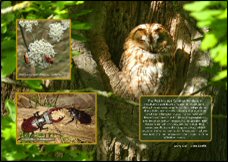
The price of the 2025 calendar remains at £6.00. Money raised from sales will be used to support the EEG’s many activities and initiatives.
The calendar will be on sale at several locations around Earley. More information on where to find them will be circulated to EEG members soon. You can order copies by email letting me know how many you wish to purchase and how we can get them to you. We will then arrange for delivery or collection.
Thank you to all the photographers who have submitted photos and to all those who have bought calendars in previous years. I hope you will be buying the 2025 edition. They will make great Christmas presents!
Bob Collis, Calendar Editor
Wednesday Volunteers 23
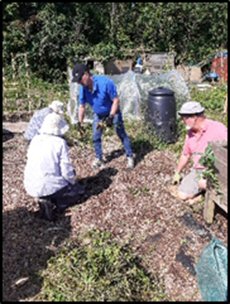
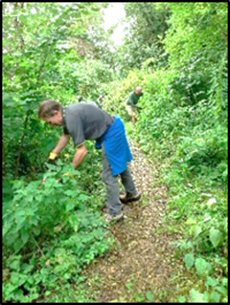
Culver Lane Redhatch Copse
|
|
EEG Talks
Reports of talks given at recent EEG meetings.
The Making of a Nature Reserve:
a talk by John Dellow
On 10 June, John spoke at the Interpretation Centre as part of this year’s Wild About Reading week. His subject was the creation and management of Kintbury Newt Ponds, describing the abundant flora and fauna of this BBOWT reserve in West Berkshire with a wealth of photographs taken over the years of his tenure as warden.
The seven-acre site was previously agricultural land, containing seven magnificent oaks and six ponds.
It was sold for building, but given the presence of Great Crested Newts, a local campaign of opposition enlisted the help of BBOWT and a compromise was reached. The reserve was formally established in 1995 and John was invited to be the warden. In 1998/99, three new ponds added, though there is no prospect of future expansion.
John reviewed the wildlife that flourishes there, concluding in more detail with the signature species – newts. It was an uplifting talk about the success of a small reserve – not dissimilar in size and timescale to Maiden Erlegh – and a testament to the efforts of a warden and community volunteers.
|
Fish & Fishing: a talk by Martyn Mills
Report by Stewart Macleod
On a very rainy evening, on 15th July, there were 18 in the audience to hear Martyn Mills give a fascinating talk about fishing in the Maiden Erlegh Nature Reserve lake.
Martyn has been a volunteer senior water bailiff for 14 years. This involves making sure only people with the correct licence fish the lake and that they follow the required rules. The lake is a Nature Reserve first. Some of the rules … No barbed hooks, no spinning or lure fishing. No floating baits, as these may endanger birds, and all boats are forbidden.
Anglers must use appropriate tackle to cope with the size of some fish in the lake, to make sure the fish are not harmed.
The lake has a gravel bottom with silt which makes it tricky to fish. Using the correct equipment helps anglers cope with these conditions. The lake averages 3-4 feet in depth with some areas around 6 feet.
Approx. 60 people are licensed to fish the lake. There are 18 fishing bays, some of which allow multiple users, so the maximum number of anglers is around 30 at one time. Usually, the only time there are 30 users is during the fishing matches that are organised from time to time.
Martyn showed us photographs of the fish he catches, Gudgeon, Roach, Rudd, Perch and various types of Carp (Common and Mirror). The largest fish he has caught was 24lbs.
Towards the end of the presentation Martyn, with Ashley’s help, demonstrated one rod he uses at the lake. He ended his presentation by showing us the large range of baits it is possible to use.
After the talk there were many questions. The main threats to the lake… silt, pollution, disease and low oxygen levels in the summer.
Martyn commented that the barley sausages put in the lake by the Wednesday volunteers, as well as controlling algae bloom, help reduce the silt.
The best time to catch fish is early morning or late evening as they tend to be dormant in the middle of the day, especially in hot weather.
After he finished Martyn let us know this was his first ever presentation. Well, you did brilliantly Martyn, you’re a natural – many thanks
|

|
|
EEG Activities
Reports of other EEG activities over the past few months.
EEG Photography Exhibition: ‘Spring’
In April and May, St Nicolas Church hosted an exhibition of spring photos submitted for the previous five editions of the calendar. The exhibition, held in The Gallery exhibition space, comprised 28 images; many of which had not been included in the EEG’s calendars. The exhibition commenced on 3rd April, ending on 12th May and included a Meet the Photographer Day on Saturday 4th May. As with the previous year’s Winter Exhibition, the talent of our local nature photographers was a joy to see.
The exhibition was commissioned by Liz Kerry and arranged by Bob Collis (below), the EEG’s calendar editor.

Bob Collis with a selection of exhibition photographs
We are grateful to the following photographers whose photos were displayed: Peter Scott, Edwin Trout, Rod MacFadyen, Cathy Garlick, Brian Hackett, Dan Twigg, Grahame Hawker, Jacquie James, Anne Bassett, Paul Rose, Freya Batchelor, Becky Thomas, Andrew McCaffrey, Henry Thompson, Grace Miller, Steve Prior, Sharon Lumbar, Stephen Lynch, Anne Booth and Emma Major.
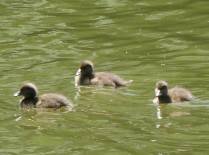
Three Tufted Ducklings in June
|
Dawn Chorus Walk
Report by Bob Collis’
Twenty three bird song enthusiasts managed the 5.30 am start on Sunday 19th April for this year’s Dawn Chorus Walk at Maiden Erlegh Local Nature Reserve. Led by Elaine Charlson and Diane Cox, the group heard 22 different bird songs. Elaine and Diane gave the group tips on how to recognise each song, with many of having a go themselves as their confidence grew.
The 22 species of birds identified and recorded were: Song Thrush, Wren, Robin, Wood Pigeon, Great Tit, Blackbird, Canada Goose, Goldcrest, Mallard, Coot, Jackdaw, Sparrow, Blackcap, Chiffchaff, Great Spotted Woodpecker, Blue Tit, Collared Dove, Magpie, Black-headed Gull, Dunnock, Stock Dove and Nuthatch.
Thank you to the ETC Ranger Ashley Prior for looking after us throughout the walk and to co-organisers Earley Town Council which suppled muffins to go with a welcome cuppa at the end of the walk.
Special thanks, however, go to Elaine and Diane for leading the walk, and to Charlotte Allchin for organising it.

Wide awake at dawn
New Life on the Lake
by Edwin Trout
As well as the expected goslings, cygnets, coot and moorhen chicks – though curiously very few mallard ducklings this year – 2024 has seen a number of unusual hatchlings on the lake. To great interest locally and on social media, the pair of grey herons roosting on the larger island produced four nestlings, two of which grew sufficiently to fly nest and could frequently be seen with their parents stalking along the pontoon. The great crested grebes that settled at Maiden Erlegh for the summer, produced two stripy youngsters in May – the first for several years. And latterly, visiting tufted ducks – so often stopping over for a few days only – stayed on and also in June yielded three chocolate brown ducklings that can still be seen diving with their mother in the centre of the lake.
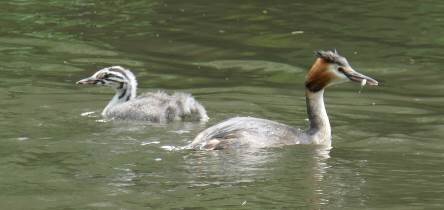
One of the two young grebes that hatched over the summer

|
|
Planning
An update on environmental aspects of local planning
Swallows Meadow
It is understood that Reading University’s plan for Swallows Meadow may include an area of wetland plants and a wildlife tunnel under Lower Earley Way, although plans are still being finalised. The EEG has agreed to help the University with the installation of two kissing gates and the meadow’s signs. The EEG’s logo will be included on the signs for the meadow.
Green Corridors Network
Reading University has said that in principle it will support the EEG’s proposals for the Earley Green Corridor Network, which includes the Whiteknights Campus. With Earley Town Council and Reading University on board, the EEG will again seek support from Wokingham Borough Council (WBC). The EEG will also be seeking support from Thames Valley Park.
The EEG will also be looking for support from the Council and EEG members to help with installing marker stakes to waymark the routes along the future green corridors.
|
Wokingham Local Plan Update
By John Booth
The Wokingham Local Plan Update for submission to the government inspectors is imminent. There will probably be only six weeks for citizens and EEG to submit comments for consideration before the Examination in Public which will probably start next year. It will be important to see what is proposed about low-carbon design criteria, wildlife conservation, and control of sizes and styles of homes to meet local needs – as well as housing numbers, development locations, and infrastructure provision.
The government has a target to create 1.5 million new homes in the next five years. It has just proposed major changes to the National Planning Policy Framework - out for consultation until 24th September. The new method of calculating housing numbers would increase Wokingham’s annual housing growth by 75% or 2,800 over the next five years. It is not clear how soon the changes in the NPPF will be mandatory in Wokingham but the pressure will be on.
I think development planning and control, and local authority funding, should be strengthened so we get good homes in good places in good time and stop developers pleading ‘viability’ arguments to avoid sustainability requirements, and slowing development to maximise profits. A ‘multi-purpose land use framework’ – proposed by government in 2023 - should be put in place.
It is expected that the Hall Farm ‘garden village’ (4,500 homes in previous draft plan) south of Earley with a bridge over the M4 to the B3270 in Earley at Meldreth Way will still be proposed. It would have significant impact on local transport, wildlife, air quality, infrastructure, services, employment and resources and take a large area of farmland. See this article for opposition and an alternative location to be considered.
Another issue for the Local Plan is the proposed ‘Third Thames Bridge’ linking Caversham to the A3290 in Earley. It would certainly be expensive and affect the Thames-side environment and landscape. It would probably increase traffic through Wokingham Borough and encourage more use of motor vehicles unless restrictions or charges are imposed. It may only make sense with a Caversham bypass (at extra cost) to connect Oxfordshire to the bridge.
|
|
Out now
The latest book from our resident bird expert has been published.

The cover of Ray’s latest book

The Common Gull, photographed on Maiden Erlegh Lake in 2016
“With so much interest in the nomenclature of birds, Ray Reedman’s latest book provides a timely addition to the genre. Personally, I love these kinds of books, and, like many birdwatchers, I have several titles on my shelves which explore and celebrate the etymology of bird names, both vernacular and scientific. The Vanishing Mew Gull seems to combine the best parts of these existing volumes, also adding to them, providing a very accessible, informative, and genuinely enjoyable read.”
(Jon Carter, BTO website)
“I liked the author’s dry humour and self-deprecation. His Preface endeared him to me as a man with a good appreciation of his subject.”
(Mark Avery)
|
Words and Birds
By Ray Reedman
Some of you may recall that I wrote about the naming of the Robin a while ago. My particular interest is in the language of bird names. In 2016 Brian Hackett drew your attention to my first book on that subject, Lapwings, Loons and Lousy Jacks. During Covid lockdowns I set out to on a particularly demanding task: that of explaining the names, in both English and Latin, of about 1100 species that are found in Europe and its near regions. As a result, my new book, The Vanishing Mew Gull - a guide to the bird names of the Western Palaeartic, was published in April 2024. Its main title is a quirky summary of something that really happened (to the name rather than to the bird that wore it). I am glad to report that the first few professional reviews suggest that the effort was not wasted.
The bird of the title sometimes appears on Maiden Erlegh Lake in winter, among the more common Black-headed Gulls, as did the one that I photographed there in 2016, but they do so under the English name of the Common Gull. It is not that common in fact, but that dubious name was imposed in 1768 by the ornithologist Thomas Pennant. In much of Britain, the Anglo-Saxon word mew had long been used where we now use the Cornish-rooted gull, but mew fell out of fashion in England once Pennant’s preference became the norm. However, by that time, mew had been taken to the Americas with the early settlers. When, in 1831, the Scottish explorer, John Richardson, identified a new American gull as the Short-billed Mew Gull, the name became formalised, then shortened to Mew Gull. Scientists later considered the Mew Gull to be the American subspecies of Common Gull and for a time the name Mew Gull was used as the international name for both forms. Then DNA analysis proved that to be wrong and, in 2021, Common Gull was at last freed from its American label. British birders had, in any case, studiously ignored the imposition and noticed no difference. Our bird remained Larus canus – literally the Latin for ‘grey gull’, but the Americans took a different line. Considering the Mew name to be inextricable from the Old World species, they decided to revise Richardson’s original name, but as the Short-billed Gull. Its scientific name Larus brachyrhynchus says the same thing in a combination of Latin and Greek. Mew just disappeared.
I must admit that I was pleased to see a messy matter tidied up, but then the linguist in me had a twinge of conscience: the word mew was, after all, as old as the English language itself. It had not changed since it was uttered by Anglo-Saxon settlers during the decline of Roman rule. It was already several centuries old when Viking raids began. If the word had been an Anglo-Saxon brooch it would have been in the British Museum. Yet there it was, discarded like an old wrapper, disused after at least 1500 years of service. Terribly sad, really! Worthy at least of a title story!
|
|
EEG Programme
We list the Group’s forthcoming walks and talks – and to the right, reports of practical conservation.
2024 Programme
Walks and Talks
Please see the EEG website and public notice boards for further details and updates.
Saturday 3 August
The Green Fair
Sunday 1 September
Bat Walk
8.00 pm in Maiden Erlegh Nature Reserve.
Led by Berkshire Bat Rescue
Wednesday 9 October
Autumn Litter Pick
Sunday 27 October
Photography Walk
11am in Maiden Erlegh Nature Reserve.
Led by Bob Collis
Sunday 24 November
Chalfont & Pearmans Copse
Walk 6 from the Earley Walks and Cycle Routes book
Contributors
Charlotte Allchin
John Booth
Elaine Butler
Bob Collis
Stewart Macleod
Ashley Prior
Ray Reedman
Edwin Trout
Reading Festival clean-up
Reduce the tonnage of nearly new but abandoned camping equipment that would otherwise be bulldozed. A chance to salvage goods for fund-raising. For information or to volunteer: TonyD127@hotmail.co.uk
|
Climate Records Broken: Not in a Good Way
By John Booth
The Copernicus Climate Change Service (C3S), managed by the European Commission, revealed that June 2024 was warmer globally than the hottest June on record and the 13th month in a row of record-breaking temperatures. The average European temperature for June 2024 was 1.57°C above the 1991-2020 average for June.
The ‘Keeling Curve’ records CO2 levels in Hawaii – far from most man-made sources so a good place to monitor global atmospheric trends. It shows year-on year increases and seasonal variations in line with vegetation growth. Commenting on May 2024 results the director of the program said “Not only is CO2 now at the highest level in millions of years, it is also rising faster than ever. Each year achieves a higher maximum due to fossil-fuel burning, which releases pollution in the form of carbon dioxide into the atmosphere”.
In July 2024 the Government’s Climate Change Committee reported: “Recently, we’ve seen the wettest 18 months on record in England. Thousands of acres of farmland have been submerged for extended periods, leading to the loss of crops and animals. The impact of this is expected to be felt well into 2025. Livelihoods have been disrupted and lives lost in the UK and overseas as a direct consequence of climate impacts, which are becoming more severe. Only a third of the emissions reductions required to achieve the 2030 target are currently covered by credible plans.”
Local initiatives:
Wokingham Borough’s plans for a ‘Solar Farm’ at Barkham were in jeopardy when Scottish and Southern Electric Networks said they could not connect it to the grid until 2037, though this has now been resolved and generation is expected to start in summer 2026.
The Council is promoting ‘Solar Together’ to get people good deals on solar panel installation and/or battery storage by ‘bulk buying’. A number of Earley residents took up their offers last year. This year the scheme says prices will be even better – registration to join in for assessment and estimates closes on August 9th.
Heat pumps deliver three or four times more heat per unit energy input than gas boilers – but standard electricity prices are three or four times gas per unit energy. Some electricity suppliers are now offering ‘Heat Pump Tariffs’ – reduced electricity prices (perhaps at low-demand times of day) for homes with heat pumps. There are also calls to shift the ‘green levies’ from electricity to gas. Both these initiatives would make running heat pumps more competitive.
Whether or not you’re considering getting a heat pump, now is the time to plan to improve your insulation before winter.
EEG Newsletter
Edited by Edwin A.R. Trout, Earley Environmental Group.
Printed for the Earley Environmental Group by Purco Print.
Printing costs covered by a grant from Earley Town Council
|
|
|